
Who is Matthew Attard?
Eve Cocks [EC]: Matthew, I was recently contacted by an artist-friend of mine to inform me about your participation at the 42nd edition (last edition) of Arte Fiera in Bologna.
Matthew Attard [MA]: This happened in February. I had exhibited some of my work as part of the Galleria Michela Rizzo stand. It turned out to be a very exciting experience as one the works – Untitled (You are a Poser!) – was chosen for the Euromobil Under 30 prize.
EC: What is the Euromobil Under 30 prize?
MA: Euromobil is the main sponsor of the art fair and the prize is aimed at giving recognition to young upcoming artists. It is the galleries themselves who nominate their young artists for the prize. This year the jury opted for an ex-aequo and awarded me and another artist, Barbera de Vivi.
EC: Were you the only artist represented by Galleria Michela Rizzo?
MA: No, there were others; we were about eleven in all.
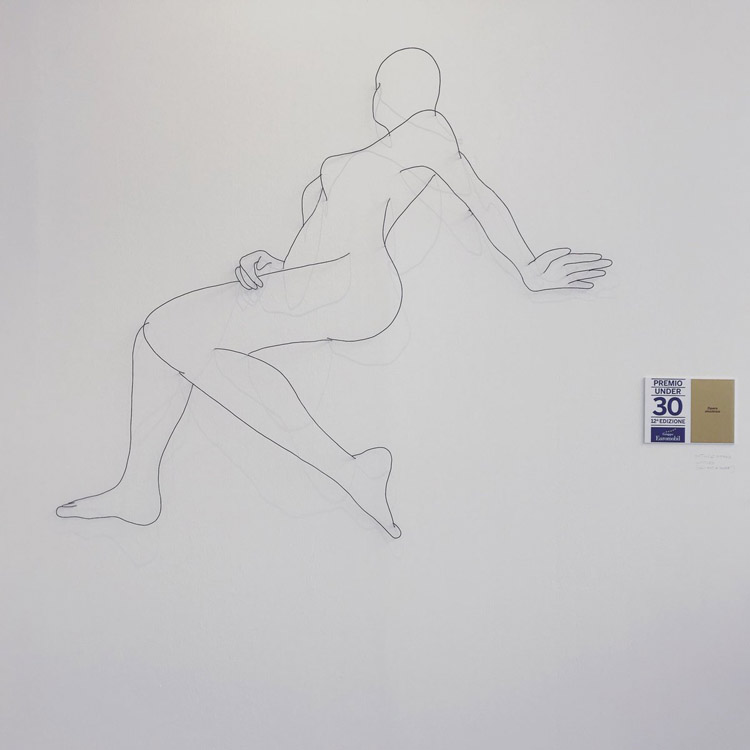
Untitled (You are a Poser!) @ Galleria Michela Rizzo stand, Artefiera Bologna, 2018 (Black aluminium wire, wall)
Work chosen for the Euromobil Under 30 Award
Courtesy of: Galleria Michela Rizzo
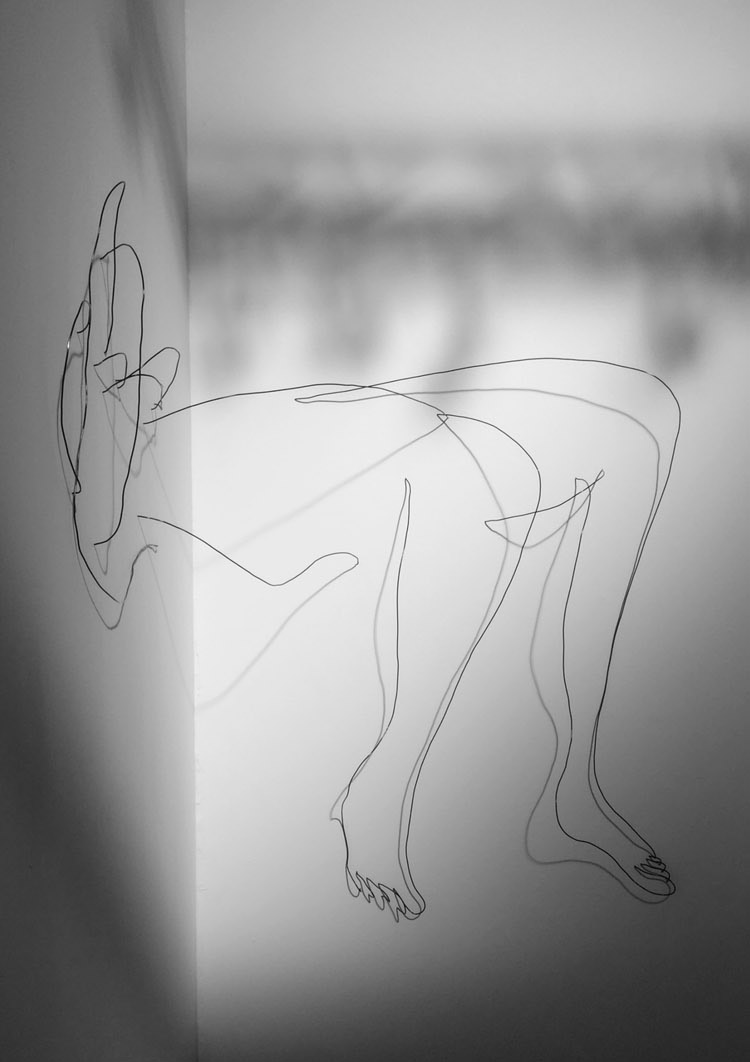
Untitled (You are a Poser!) @ Galleria Michela Rizzo stand, Artefiera Bologna, 2018 (Black aluminium wire, corner)
Courtesy of: Galleria Michela Rizzo
EC: How did the gallery owner (Michela Rizzo) get to know about your works/art practice in general?
MA: Michela had asked me to exhibit for the first time at her gallery in Venice in 2011 – she had offered me a Project Room show where I exhibited two of my works. These formed part of a series of sculptures that I had produced at a studio in Forte Marghera that same year as part of an artist’s residency. The Project Room show was offered to me after Michela got to know about my work through one of her collectors. After that, more exhibition opportunities came along (both in Italy and abroad). At the same time I also used to work at Michela’s gallery, helping out with the organization of the gallery’s shows and events. This has not only given me the opportunity to meet a great number of artists, curators , collectors…but also gave me crucial experience in the art world.
EC: Are you currently living in Malta?
MA: Yes, but I do travel on a regular basis for shows, etc…
EC: We haven’t yet talked about the actual work that was exhibited at the Arte Fiera. Was Untitled (You Are A Poser!) made specifically for the Arte Fiera? And how does it relate to your previous works?
MA: The work forms part of series of works which I had exhibited at a gallery in Brussels in 2014 – the exhibition was called You are a Poser! Like most of my work really, the series was inspired by human poses which I appropriated from fashion magazines, bill boards…basically from the saturation of images that we live in.
Untitled (The Three Graces), 2014
Plexiglass, Black aluminium wire, Black paint, Wall
Courtesy of: Galleria Michela Rizzo, Venice
EC: Your works (in general) are not as straightforward as they seem, in the sense that, it does take the viewer some time until he/she gets to see the full image of the human body.
MA: I’m interested in the way the viewer approaches/experiences the work, or rather an image. I invite the viewer to experience a personal visual discovery in relation to the space in which these wire-sculptures are setup.
EC: At first sight they look like scribbles.
MA: Most of the viewpoints consist of abstract and fragmented forms.
EC: Mat, what triggered your interest in wire-sculpture?
MA: I think my interest in drawing itself. I’ve always been fascinated by drawing. In fact it plays an important role in the formation of my work – that’s how it all starts really.
EC: This explains why your studio walls are littered with drawings?
MA: Yes, but those drawings go way back…
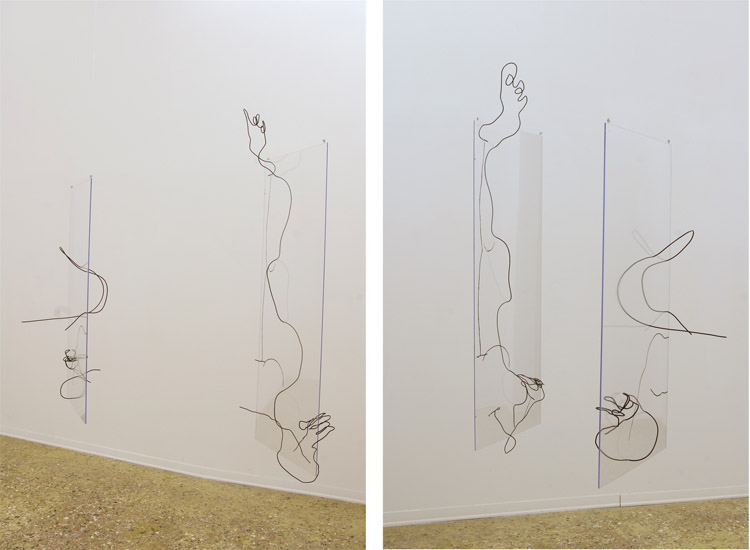

Top & Bottom: Untitled (Pose) – different viewpoints from the Project Room exhibition in 2013
Plexiglass, Black aluminium wire, Black paint
Courtesy of: Galleria Michela Rizzo, Venice
Photo credits: Mauro Ghiglione
EC: Are there any artists you have been influenced by?
MA: There are definitely many artists which interest me and whose work I follow, other influences do not necessarily concern the art world. I was lucky to meet with several influential persons from the contemporary art world through Michela’s gallery, like Vito Acconci, Muntadas and Richard Nonas amongst others.
EC: I thought you were going to say Alexander Calder…
MA: Well, of course I like his work and I think they are very relevant of their own era.
EC: So…how did Acconci influence you?
MA: Rather than influence, I am more interested in the way he thought and in how he lived his life. Most of us know Acconci through his performances, a practice which he had pioneered and yet had no problem surpassing as soon as he felt the need to evolve into a next project. What I like about Acconci is this energy and willingness to ceaselessly develop through different practices. Because of this he did not feel the obligation to particularly categorise and define his work by using any conventional framework. I remember once Acconci and I were talking on how, as a discipline, art gives great possibilities for its doers to bridge towards other disciplines and interests, but at the same time this should be done with great caution and critical thinking as the term ‘artist’ (in our contemporary times) risks suggesting some kind of ‘supernatural’ power. In fact he disliked this word.

Various works @ Matthew Attard’s Studio
Photo credits: evecocks.com
Courtesy of: Matthew Attard
EC: I guess that Acconci’s approach is what triggered your interest in undertaking an MFA in Digital Arts at the University of Malta?
MA: I don’t know. I think there were many factors which triggered my interest in enrolling for this field of study. Nonetheless, it did allow me to bridge with other disciplines, opening different avenues in the development of my art practice.
EC: What kind of avenues?
MA: The focus of my research was to test if we could draw with our eyes.
EC: Okay…and how is that possible?
MA: Through using an eye tracker which detects the movements of our pupil. I am interested in how to use ways of looking and their respective recorded data as a drawing practice. The tests that you are seeing below are some of the trials that I undertook with my tutor Prof. Vince Briffa and the current MFA students.
EC: And what are they meant to represent?
MA: Seven superimposed eye drawings of a figure by seven different individuals. What I found most interesting in these results is how distinctive each eye-drawing turned out in view of the fact that the ‘artist’s’ hand is obliterated from the drawing process.
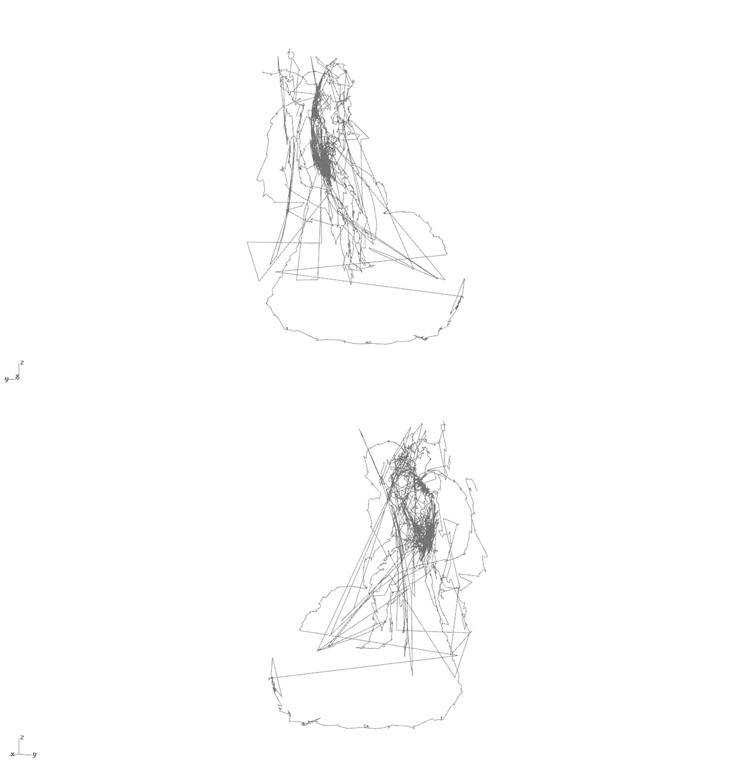
Two different viewpoints of seven superimposed eye drawings of a figure
Done in collaboration with the MFA students at the Digital Arts Department, University of Malta
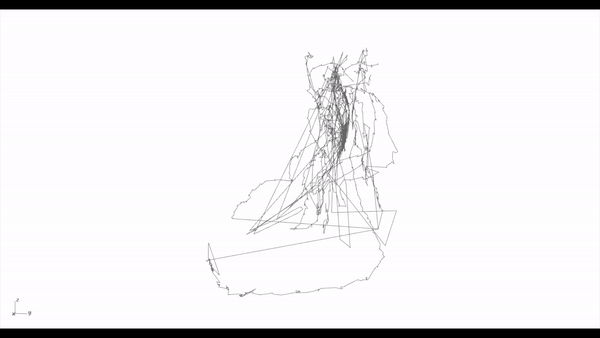
Rotating model of seven superimposed eye drawings of a figure
Done in collaboration with the MFA students at the Digital Arts Department, University of Malta
EC: I presume that the jagged lines are the eye movements?
MA: Yes they are.
EC: Could we consider these eye drawings/trials as works of art?
MA: Well, I am currently working on ways of developing these works, and since the ‘drawings’ exist as data (as coordinates), the possibilities of exteriorising them are many.
EC: The concept of removing the artist’s hand harks back to Marcel Duchamp’s quest in wanting “to put painting once again at the service of the mind”, as to challenge people’s habit of judging (good or bad) art on the basis of taste (according to how visually pleasing an art work is). What triggered your interest in wanting to eliminate the artist’s hand?
MA: Well, to a certain extent it started off as a hunch, and since most of us have the tendency to judge a drawing according to how ‘good’ an artist’s hand is, this is one way to test a different way of drawing which does not include the hand gesture. Several questions then arise, like for example: “does one need to be an artist or know how to draw to be able to attempt an eye drawing?” It somehow levels the capability to draw between practitioners and non. It also gives the opportunity for a different way of looking at the world.
EC: I recently passed by the Malta School of Art (Valletta) and I saw one of your eye drawing tests exhibited there (feature image).
MA: That piece was specifically made for the Visual Acoustics international exhibition (VAC). The concept behind the exhibited work is linked to the theme of the exhibition of visualising sound, and it consists of eye movement data which I recorded whilst I was listening to different genres of music and staring at a blank wall (in this case I was listening to ‘The Ramones’). As I mentioned earlier, I’ll be now focusing on possible developments of this typology of work, similar to what I also showcased in Bologna alongside Untitled (You are a Poser!).
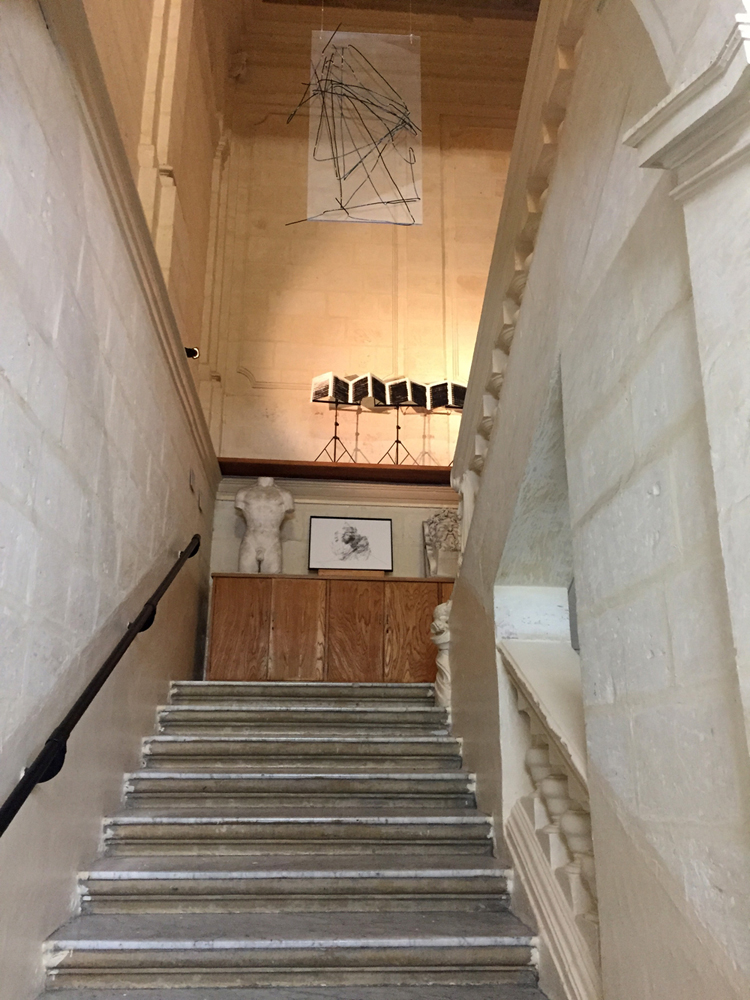
Visual Acoustics Installation shot @ Malta School of Art, Valletta
Top: Matthew Attard, A 1-second eye-drawing while listening to the Ramones, Wire sculpture, 2018
Middle: Vince Briffa, Ripples in a Pond, 2018
Bottom: Matthew Attard, A 30-second eye-drawing while listening to the Ramones, Digital Print, 2018
Photo credit: Zsolt Gyenes
Courtesy of: Malta School of Arts, Valletta International Visual Arts Festival
If you would like to know more about Matthew Attard’s practice click on these links _matthew_attard_ , matthewattard.com
FEATURE IMAGE: Matthew Attard, A 30-second eye-drawing while listening to the Ramones, 2018 (Digital print). Courtesy of: Matthew Attard
